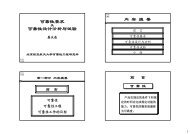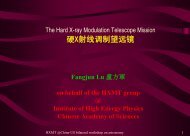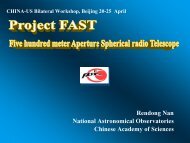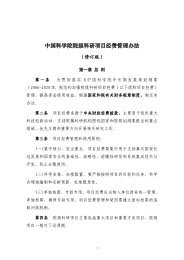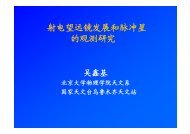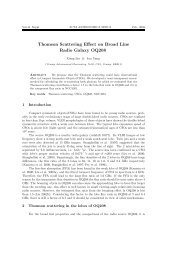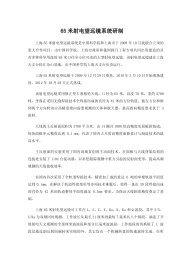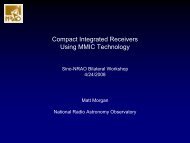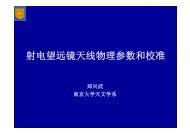Weak Gravitational Lensing
Weak Gravitational Lensing
Weak Gravitational Lensing
You also want an ePaper? Increase the reach of your titles
YUMPU automatically turns print PDFs into web optimized ePapers that Google loves.
<strong>Weak</strong> <strong>Gravitational</strong> <strong>Lensing</strong><br />
Jason Rhodes (NASA JPL)<br />
Frontiers of Cosmology at Dome A Antarctica<br />
July 21, 2009
The Components of the Universe<br />
Dark Energy<br />
73%<br />
All of chemistry,<br />
biology, physics…<br />
Neutrinos 0.3%<br />
Stars 0.4%<br />
H, He Gas 4%<br />
23%<br />
Dark Matter
<strong>Weak</strong> <strong>Gravitational</strong> <strong>Lensing</strong><br />
<strong>Weak</strong> lensing effect cannot be measured from any individual galaxy.<br />
Must be measured statistically over many galaxies<br />
z galaxy ≈1<br />
z<br />
z observer =0<br />
lens ≈0.3–<br />
0.5<br />
If there is any intervening large-scale structure, light follows the distorted<br />
path (exaggerated). Background images are magnified and sheared by ~2%,<br />
mapping a circle into an ellipse. Like glass lenses, gravitational lenses are<br />
most effective when placed half way between the source and the observer.
Why Space?<br />
•Size of PSF<br />
•Stability of PSF<br />
•Better shape measurements<br />
•Lower shape systematics<br />
•Higher surface density of resolved galaxies
Why Not Space?<br />
• Single facility- time is expensive!<br />
• Small field of view<br />
— 10 square arcminutes for ACS<br />
(similar for WFC3)<br />
—Of order 1 degree from the ground<br />
• Some systematics hard to address<br />
(e.g. CTE)<br />
• Expensive to even THINK about new<br />
instruments
Why Space in the Future<br />
• PSF Stability greatly increased with proper thermal<br />
environment & design<br />
• Space specific systematics being addressed<br />
• Near Infrared (NIR) coverage<br />
—Deeper survey<br />
—Photo-z’s<br />
• Lower background<br />
• Dark matter mapping (sensitive mostly to N eff )
Bullet Cluster<br />
Purple is dark matter<br />
Pink is X-ray<br />
emitting plasma<br />
Clowe, Bradac et al 2006.<br />
Due to the collision, the dominant baryonic component is in a<br />
different position than the total mass. Thus, most of the mass is<br />
dark matter.
Dark Matter Ring<br />
•Strong and weak<br />
lensing<br />
•Dark matter and<br />
baryonic matter<br />
displaced, like in<br />
bullet cluster<br />
•Due to a collision 1-<br />
2 Gyr ago<br />
•Only possible with<br />
high resolution and<br />
high surface density<br />
of HST<br />
Jee et al 2007
Abel 901/902Supercluster<br />
•<strong>Weak</strong> lensing shows<br />
dark matter and<br />
cluster galaxies have<br />
same distribution<br />
•BCG mark peaks in<br />
DM distribution<br />
•Resolve substructure<br />
within/between<br />
clusters<br />
•Did not find<br />
filamentary structure<br />
seen from the ground<br />
(systematics)<br />
STAGES; Heymans, Gray et al 2008
Dark and Visible Matter<br />
<strong>Weak</strong> lensing<br />
mass contours<br />
(HST)<br />
Extended x-ray<br />
emission<br />
(XMM-Newton)<br />
Galaxy number<br />
density<br />
(Subaru/CFHT)<br />
Galaxy stellar<br />
mass<br />
(Subaru/CFHT)
3-D dark matter distribution<br />
z=0.7<br />
z=0.5<br />
z=0.3
Systematics as a function of PSF Size<br />
Plot courtesy of<br />
Henk Hoekstra<br />
m STEP is the multiplicative bias on the shear (shape) as calculated via the STEP program [Heymans et<br />
al 2006; Massey et al 2007a]. The m STEP values are shown for the KSB measurement method [Kaiser<br />
et al 1995] as implemented by Hoekstra et al [2009]. The top (dotted red) curve is the level of<br />
systematic for a typical ground-based survey (0.7” PSF) and the lower (solid black) curve is for a<br />
space-based survey (0.15” PSF). The dotted horizontal line is what will be needed by LSST and<br />
JDEM/Euclid to prevent systematics from dominating the error budget. This shows that with the same<br />
shape measurement method, a smaller PSF size reduces systematic errors by more than the ratio of the<br />
PSF sizes.
Shear-Shear Comparison :<br />
All Matched Galaxies<br />
RMS = 0.2<br />
Slope = 0.7
Shear-Shear Comparison:<br />
Most Consistent Subset<br />
Subset :<br />
21 < Mag < 24.5<br />
1.8 拻 < Size < 3.2 拻<br />
RMS = 0.1<br />
Slope = 0.97
Noise From the Ground and Space<br />
Noise in mass maps of the COSMOS field from the ground (left; Subaru)<br />
and space (right; HST). The ground-based map is noisier and produces<br />
‘false positives.’ Precision lensing measurements must be done from<br />
space!<br />
From Kasliwal, Massey, Ellis, Miyazaki, and Rhodes, 2007
Potential Balloon Experiment: The High Altitude <strong>Lensing</strong> Observatory<br />
•15-20 day balloon mission<br />
•Fly Australia- Australia<br />
•400Mpix, 1.2m mirror<br />
•200+square degrees<br />
•Above 99% of atmosphere<br />
High systematics and<br />
programmatic risk<br />
DOME A??<br />
Low systematics and<br />
programmatic risk
JDEM<br />
• NASA/DOE Joint Dark Energy Mission<br />
• Synthesis (??) of several concepts<br />
including SNAP, ADEPT, Destiny<br />
• Plans to do a 20,000 square degree weak<br />
lensing survey<br />
• Currently NIR only<br />
• 1.5m mirror<br />
• ~100M-150M pix<br />
• 2017 launch<br />
• $1-2B<br />
• Merger with European concept-<br />
International Dark Energy and Cosmology
Euclid<br />
•ESA led concept<br />
•Dark energy mission with weak lensing as a<br />
primary science driver<br />
•20,000 square degrees for WL and BAO<br />
•Smaller, deeper survey for DM<br />
•Single optical band for shapes<br />
•3 NIR bands for photometry<br />
•1.2 m mirror<br />
•2017+ launch<br />
NIR Photometric<br />
channel<br />
Vis. Imaging<br />
channel<br />
Spectroscopic<br />
channel
Final Questions<br />
•What aspects of a space-based survey can be achieved from the<br />
ground at Dome A?<br />
•What are the costs?<br />
•What is the time frame?<br />
•What are the risks?
Issues already raised<br />
•NIR ok for WL<br />
•Must have good sampling (2 pixels per FWHM)<br />
•Ground is fundamentally limited by PSF instability<br />
•Is this true at Dome A<br />
•Don’t consider ground-based projects competing if not<br />
•10,000 square degrees IS competitive<br />
•Especially if data is space-quality<br />
•Full 20,000 costs $1B or more



